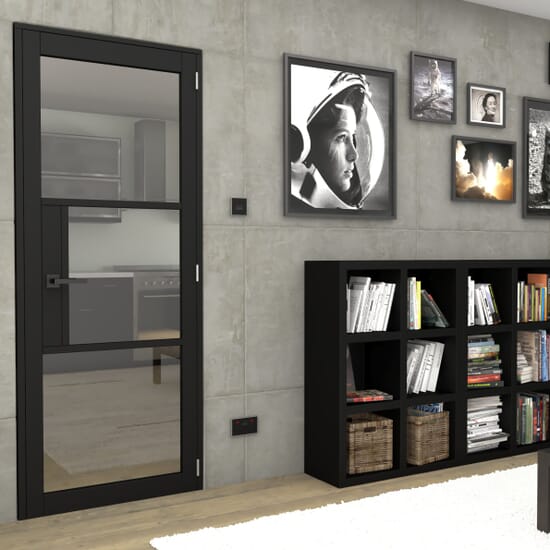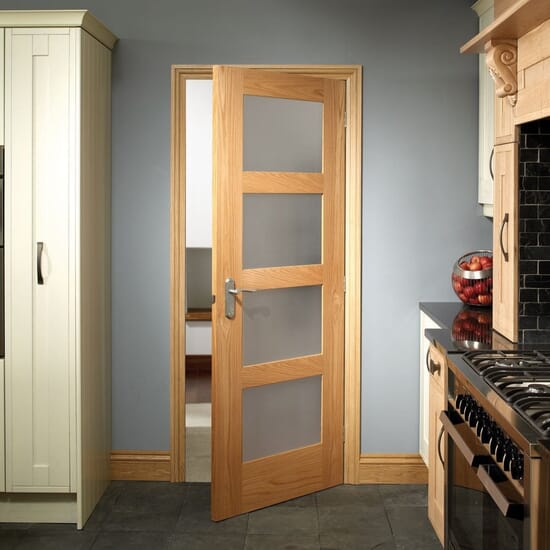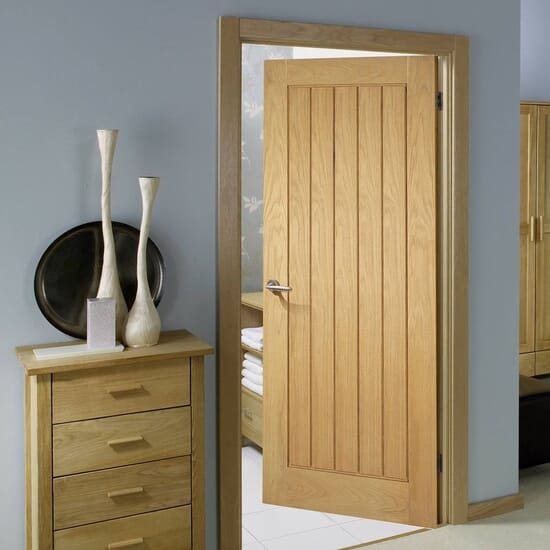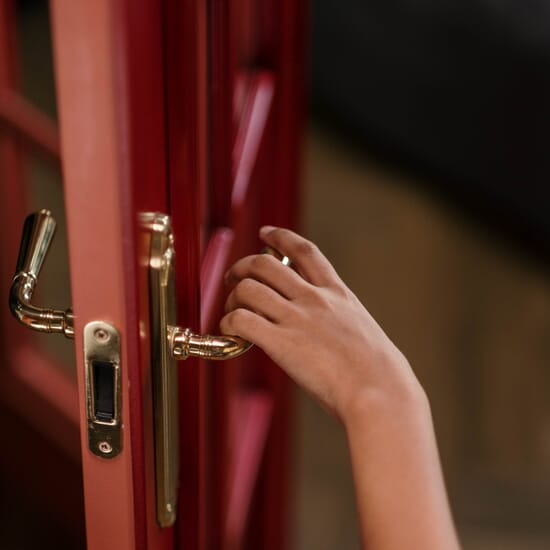What Types Of Internal Doors Are Available?
Panelled doors are the traditional choice for elegance and don’t need to be confined to period properties alone. They are made of wooden “rails” (the horizontal bits) and “stiles” (the vertical bits) with recessed panels filling the gaps. You can enjoy the natural beauty of wood by staining and/or varnishing them or you can paint them to enhance the decorative scheme of your room.
Flush doors are completely smooth and flat. Although they could theoretically be made of solid wood, they are more usually made of a simple softwood frame stapled together and covered on both sides with plywood or hardboard. The edges are then finished with hardwood strips known as “lipping” although the most basic doors may not even have this.
Fire doors are designed to look like regular internal doors, but with added fire rated protection. Most domestic fire doors are FD30 rated, which means they're capable of withstanding fire and smoke for at least 30 minutes, making them a popular choice in kitchens, utility rooms and ajoining garages.
Glazed doors will have some or all of the wooden panels replaced by glass. These are ideal for improving the illumination between receptions rooms, hallways and kitchen if you’ve got dark corners. They can help give the illusion of a more open plan feel without losing the ability to close rooms off when required.
Bifold doors and French doors are not just patio doors - internally they are useful if space is at a premium or you want to create an open plan feel. Rather than opening back or forth, the panels in bifold doors concertina back to maximise space without the need concerder where the open door will sit, bifold doors will allow you to essentially remove entire walls if needed, with the option to completely close off a room if you want privacy.
Engineered wood is often used on many of these internal door designs to give a beautiful veneer of real wood without the expense of a solid construction. This allows timber resources to be used in a more sustainable way while still giving your home the stunning, natural appearance of real wood. Engineered wood also has more insulating properties allowing to keep heat and sound within your rooms.
What’s The Difference Between Solid Core And Hollow Core Doors?
Unless you’re going for the all-out luxury of solid wood doors, you should check whether you are buying solid core or hollow core doors. Each has their own benefits.
Solid core doors
- are made from “composite” - a mixture of wood particles glued together with heat, resins and hydraulic pressure to produce a uniform, consistent product.
- are dense and heavy, withstanding more everyday punishment.
- provide more security – this may be important in a house of multiple occupancy.
- provide more protection against fire, although they should not be considered a fire door.
- are more thermally efficient.
Hollow core doors
- have a softwood frame covered with a thin layer of plywood and filled with a fibreboard honeycomb structure to avoid warping and bending.
- offer the appearance of a solid door without the expense.
- are suitable for internal use only - intruders could easily break through them and they are not weather resistant.
- are not good sound insulators - this may be important if sound transmission is a deciding factor when buying.
- are lightweight – this can make installation somewhat easier and quicker.
- have a lock block (a solid 300mm length of wood) inside one side of the door – it’s important to check which side so that you fit the lock to this solid piece of wood rather than the hollow section.
What Sizes Are Internal Doors Available In?
The most commonly available height for doors in the UK is 1981mm (6ft 6in) although some may also be available up to 2032mm (6ft 8in). This is not a standard size for all properties however and you should always measure your own doors and frames before making a purchase.
There is generally more choice of widths because door apertures vary more in size, especially for cupboards or smaller rooms like bathrooms. Measure your opening (not the current door) carefully and buy a door that is slightly wider rather than narrower. You can always shave a little width off the door but you can’t add any more on!
Do Interior Doors Come Ready Finished?
Primed doors have been given a protective coating so that they are ready for you to paint your chosen colour.
Unfinished doors (usually solid or engineered wood) are left for you to oil, wax, stain, paint or varnish as you wish.
Prefinished doors are ready to hang as they are – no need to do anything else.
Choice of finish really depends on personal preference. Unfinished doors give you complete control, primed doors save you some time but still allow you to paint the doors as desired. Unfinished and primed doors are useful when purchasing new doors, so you can match them to the rest of your interiors. Prefinished doors save a lot of time and effort as they are completely ready for you to fit after delivery.
What Else Will I Need To Buy Apart From The Doors?
You’ll need door hinges and screws. It’s worthwhile measuring the sizes of the current hinges as you may be able to install the new hinges in the same position as the old door. Generally, 75mm in length with 3 screw holes in each leaf is the norm. Lighter weight doors can be fixed with two hinges top and bottom, but heavier doors will require a third hinge in the middle.
For a swish finish you could match the hinges to your door hardware. Handles, knobs and locks come in a wide array of styles and materials. Chrome or gold are the more everyday choices, either brushed, matte or shiny, but rose gold, brass and copper finishes are also available if you want to up the style stakes to create a co-ordinated look to match other fittings in your rooms.
Once you’ve made some design decisions, you’re ready to measure up and have a look at what door manufacturers have to offer to suit your needs.
In Summary
When choosing your interior doors, you should take into consideration the design, the finish and the size. The measurements are first and foremost important as you need to ensure they fit your space. The design and finish you have more control over. There are a variety of wood and glazed internal door options to choose from and each has their own benefits. If you wish to add light into your rooms, window panelled doors are a great investment. They are stylish and open and look stunning in any home. Frosted glass is also a great alternative for when you wish to have decorative doors but need more privacy – for example your bathroom or bedroom doors. When looking at the designs, consider the placement of the doors within your home. Some rooms have different requirements. You may want transparency for your hallway doors but you may wish to close off your living room, so you can relax and unwind from the rest of the house on an evening.
Consider which design you like but bear in mind the practicalities. Once you have found a design you like, and the measurements match up, check the finish before making your purchase. Often you will find a choice between prefinished and unfinished doors, the latter option gives you more control over your home decoration.







